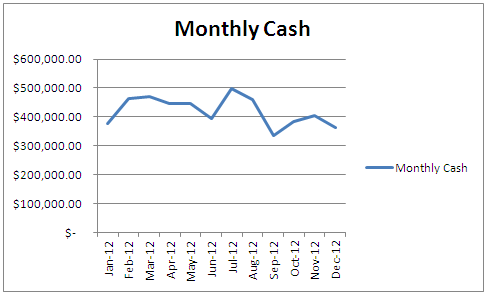Use Cash Fow to Spot Problems Early
Post on: 24 Апрель, 2015 No Comment

Use Cash Flow to Spot Problems Early
Investors who bought Krispy Kreme Doughnuts at its August 2003 peak and never sold would have $150 worth of stock today for every $1,000 that they originally invested.
But that didn’t have to happen. Those savvy to analyzing cash flow statements had plenty of warning that something was amiss. Here’s why.
On August 10, an investigation commissioned by the doughnut maker’s Board of Directors reported that senior management had resorted to creative accounting in the 2000 to 2003 timeframe to assure that the firm would report ever-growing earnings, which was necessary to keep its share price moving up.
Despite those efforts, in August 2003, Krispy’s accounting house of cards fell apart, earnings growth evaporated, and its share price plunged.
The investigative report found that Krispy’s accounting shenanigans involved shipping unwanted goods to its franchisees. Krispy recorded the shipments as sales, which added to earnings, even though the franchisees never intended to pay for the goods. So Krispy Kreme’s income statement gave no clue that its growth was faltering.
But the discrepancies had to show up on Krispy’s cash flow statements.
Hard to Fudge Bank Balances
Cash flow measures the cash that flowed into, or out of, a firm’s bank accounts. There is little a company can do to overstate its bank balances. Since Krispy’s franchisees didn’t pay for the unwanted shipments, its cash flow statements would reflect the shortfall.
Here’s what you what you need to know to analyze cash flow.
Cash flow statements start with net income and then add back non-cash expenses such as depreciation, which deduct from net income but don’t result in cash changing hands. Cash flow statements consist of three sections.
Cash used/from operating activities (operating cash flow): the cash flow generated by the company’s business operations.
Cash used/from investing activities: capital equipment (property, buildings and equipment) purchases, cash used to fund acquisitions, and short-term investments.
Cash used/from financing activities: cash from stock sales and buybacks and from borrowings or debt repayments.
You can see cash flow statements on most major financial websites. I’ll use Smart Money’s statements to demonstrate the analysis.
Use Annual Figures
From Smart Money’s homepage (www.smartmoney.com ), enter your stock’s ticker symbol (KKD for Krispy Kreme) and select Financials from the dropdown menu. You can use annual or quarterly cash flow statements, but the annual numbers are better suited to this analysis. So, select the “Yearly Cash Flow” option.
Smart Money’s yearly report shows the last five fiscal year’s cash flow numbers. Krispy Kreme’s fiscal year ends with January, so the fiscal year labeled 2003 is the year ending January 31, 2003. Because it’s still trying to unwind its accounting misdeeds, Krispy hasn’t yet filed its January 2005 fiscal year report, so January 2004 is the latest available.
You need consider only two items to do the analysis, operating cash flow and free cash flow.
Operating Cash Flow
Operating cash flow should be positive. A company isn’t profitable if it doesn’t report strong positive cash flow. How much is enough? At a minimum, operating cash flow should exceed the total net income (top line of the cash flow report) for the same year. Krispy Kreme reported positive cash flows, which exceeded net income, in every year shown, so it passed this test.
Free Cash Flow
Free cash flow is operating cash flow minus money spent on capital expenditures and acquisitions (listed under investment activities). It is the money left over after a firm has run its basic operations and made the additional expenditures necessary to remain competitive and to continue growing. Free cash flow isn’t shown on the cash flow statement, so you’ll have to calculate it. However, for our purposes, you can probably do the math in your head.
The best companies generate positive free cash flow, which means they have surplus cash they can use to pay dividends, buyback shares, or enter new businesses. But most fast growers need all of their excess cash to fund their expansion. In terms of free cash flow, they generally break even, on average, over the years.
Krispy, aware that investors notice negative operating cash flow, was able to keep that number positive by moving items that arguably should have been deducted from operating cash flow down into the less-scrutinized cash from investing activities section.
Calculating free cash flow would have immediately spotlighted Krispy’s problems early on. From the time it went public in early 2000, Krispy’s free cash flow was negative every year except for 2001.
Something Went Wrong
At first Krispy’s free cash flow looked reasonable. Down $2 million in fiscal 2000, but up $5 million in 2001. But then something went wrong. Krispy burned $22 million in fiscal year ending with January2002 and $37 million in fiscal 2003.
Anyone who calculated Krispy’s free cash flow after it released its fiscal 2002 report in March of that year would have figured it was time to get out. Krispy’s shares were trading in the low $40 range at the time. If they missed that “red flag,” investors had another chance when Krispy released its fiscal 2003 results in March 2003. Then, its shares were still trading in the mid-$30s. The last time I looked Krispy shares were changing hands at $7 or so.
Many experts consider cash flow more important than reported earnings. That said, not all stocks that fail my two cash flow tests will crash and burn. But failing these tests signals added risk, something that you don’t need in this tricky market.
published 8/21/05














